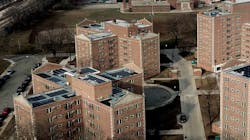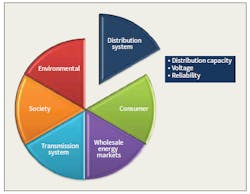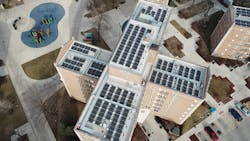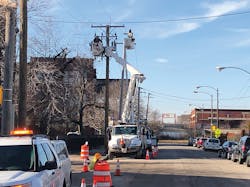ComEd Values DER
Distributed energy resources like solar photovoltaics and energy storage offer terrific opportunities to mitigate the effects of climate change and invigorate the economy. To realize this potential, electric utilities must be able to calculate the value of distributed energy resources (DER) fairly and accurately. As these resources are interconnected to the grid, they can pose challenges, including an increased need for utilities to be able to observe and control the more distributed grid.
With challenges also come benefits. By interconnecting to the grid, the resources not only potentially promote sustainability and support efforts to enhance societal resilience, but they also can make the grid more economical. This requires a rigorous analysis of how the interconnection of DER can provide value to the grid. Commonwealth Edison Co. (ComEd) has developed a methodology to do just that.
How DER Provides Value
The primary way DER provides value to the grid is by deferring traditional grid investments. DER can leverage potentially one or more of three types of resources: real power, reactive power, and reserves. As the distribution grid is designed currently, wired grid investments such as transformer upgrades or the installation of capacitor banks often are done to increase the availability of real or reactive power, respectively, in an area of the grid. Should DER be able to provide that same resource, it could defer the need for upgrades and potentially reduce the cost of planning the system.
The challenge is that the real or reactive power would have to be injected into the grid at both a particular place and time. Unlike the transmission grid, most distribution grids are radial, meaning each feeder inter-connects with only a single substation. Therefore, capacity upgrades typically are installed to mitigate constraints that occur on a feeder between the substation and certain loads or within the substation itself. Thus, a DER interconnected to an adjacent feeder does not defer projects on the feeder with constraints. Even if a DER were interconnected on the relevant feeder but upstream of the constraint, it may not be able to provide value to the planning of the grid.
DER not only needs to be interconnected at specific locations to provide value from a grid-planning perspective, they also must provide the relevant resource at the appropriate time. Because load varies over time, a constraint might only appear for a given set of hours on a given number of days. DER would need to provide sufficient real and reactive power to mitigate the constraint when it occurs. This could provide benefits to customers, measured potentially in terms of dollars and cents.
Existing Approaches
ComEd began evaluating existing methodologies to recognize the value of DER. Many of these approaches faced common problems. One approach was to use average values to determine contributions to the grid, which would reduce significantly the computational burden of implementing value-of-DER methodology.
Because a utility’s distribution system basically comprises thousands of discrete feeders interconnected only at substations, estimating an average value could lead to significantly overcompensating some DER while undercompensating others. The effect would likely increase the cost of planning the grid, because owners would be under-incentivized to interconnect DER where it is needed most. It also could lead to requiring costly traditional wired solutions and over-incentivizing DER owners to interconnect where the value may be less for the system.
Across the U.S., utilities have looked at different approaches and considered factors other than impact on the grid. A significant benefit of DER — acknowledged in other industry efforts — is reducing carbon emissions, which can be valued monetarily through estimates of the cost of carbon. ComEd recognized combining this factor with grid concerns could lead to the task of planning and operating the grid in an overly expensive way, because the utility would be required to offer incremental services.
Only by developing an approach that focuses strictly on the services DER can provide to the grid would it be possible for stakeholders to make informed decisions about it, without affecting the operation of the grid. This would make it possible to integrate high levels of renewable generation.
ComEd’s Approach
In developing this approach, ComEd was confident the primary ways DER provides value to the grid is by deferring investments to increase capacity, mitigate voltage issues and enhance reliability. The only problem was no methodology existed to make such an assessment, much less demonstrate it on a utility grid. ComEd also benchmarked with those working on the locational net benefit analysis (LNBA) in California, U.S., which similarly aimed to produce a geographically and temporally granular basis focusing strictly on the value to the grid. None of these approaches produced sufficiently granular results or considered the effects of reactive power.
To develop its methodology, ComEd formed a team with diverse talents. Members ranged from academics as well as technical and economist thought leaders in industry — who had extensive theoretical expertise in energy markets — to smart grid engineers and capacity planners — who had deep experience with the grid. Partnerships with PLUG LLC, Quanta Technology LLC and Tabors Caramanis Rudkevich helped to ensure there was the right expertise and experience to answer questions in a rigorous manner.
External experts helped to develop the mathematical theories and tools to demonstrate them in the real world. ComEd’s engineers helped to prioritize the value DER provides for capacity upgrades, because of the higher cost of deferring them, and deemphasize the importance of reduced losses along a feeder by noting such impact is largely nominal. Additionally, the utility engineers helped to explain how academic theories had to be fine-tuned to respond to the physical realities of the grid. The collaboration of these experts with varied types of skills demonstrated how a team can be more than the sum of its parts.
Broadly speaking, what emerged from this work was an innovative approach to analyzing the grid, to determine exactly what additional capabilities would be needed to mitigate emerging issues. Engineers considered potential approaches using traditional wired solutions to determine what would be the most cost-effective method to solve a problem. Once this was identified, a mathematical methodology was developed to allocate a value to any DER that might be interconnected in place of the traditional wired solution.
By emphasizing the grid contribution of DER, ComEd’s approach is technology agnostic. In other words, DER is compensated equally — regardless of whether it is photovoltaics (PV), a fly-wheel battery or demand response — if it provides the necessary energy resource at the appropriate time in the relevant location. This approach encourages stakeholders to pursue innovative approaches to integrating more advanced technologies into the grid and monetizing them from a range of value streams, including the value of DER.
As advanced technologies emerge and new forms of clean generation become economically viable, this DER value methodology can help utilities to make the grid not only more resilient and sustainable but economical, too.
Next Steps
ComEd’s approach was published in leading peer-reviewed venues and then demonstrated in 10 ComEd feeders. This represents just one step in a longer-term effort to support the integration of DER and the utility of the future as it meets the needs of customers and stakeholders, who expect the higher levels of service changing conditions demand.
ComEd now is working on enhancing the value of its DER methodology further. The utility is considering extending it across the entire system. Discussion is needed on when in the process to communicate the value of DER. There needs to be enough time to enable DER developers to interconnect their resources and, if projections do not materialize, give utility planners the opportunity to move forward with a more traditional approach.
The utility also must determine how an approach can be used to maximize the value for all stakeholders, including the possibility of the value of DER remaining in the possession of the electric utility and its regulators. This could benefit customers if DER developers agree to interconnect with even a reduced value-of-DER incentive should the alternative value streams, such as from the sale of energy or renewable energy credits, be sufficiently appealing.
As the DER value methodology is used in more cases, greater numbers of customers and developers will be able to receive appropriate incentives to interconnect DER that supports efforts to mitigate climate change and enhance resilience, like microgrids. To smooth the process of integrating DER, ComEd is developing and implementing technologies, like a hosting capacity map, so stakeholders can make informed decisions about where to install generation, like PV, as well as technologies to accelerate the interconnection process for smaller quantities of generation.
To make this even more of a reality, ComEd is developing and leading partnerships that bring together the best minds to produce innovation and then make these technologies accessible to the communities it serves. Linked together, these efforts represent a significant step forward in making real the possibilities of the new energy future.
For more information:
Quanta Technology | https://quanta-technology.com
Tabors Caramanis Rudkevich | https://tcr-us.com
About the Author
Shay Bahramirad
Shay Bahramirad is the vice president of Engineering and Smart Grid at ComEd, where she serves as a strategic business leader in Commonwealth Edison, the electric utility serving Northern Illinois including Chicago, holding executive responsibility for ComEd’s vision of the grid of the future as well as communities of the future, system reliability, engineering, and planning. She completed her PhD in electrical engineering at the Illinois Institute of Technology.
Aleksi Paaso
Aleksi Paaso is director of distribution planning, smart grid, and innovation at Commonwealth Edison Co., where he is responsible for leading the development and implementation of short- and long-term strategic smart grid initiatives, including the first utility-operated microgrid cluster, as well as planning the distribution system for all of northern Illinois. He completed his PhD in electrical engineering from the University of Kentucky and is a licensed professional engineer in the state of Illinois.
Ralph Masiello
Ralph Masiello is an industry advisor for Quanta Technology, where he provides insight on topics dealing with power systems. He is a Life Fellow of IEEE and is a member of the National Academy of Engineering. He completed his PhD in electrical engineering at the Massachusetts Institute of Technology.
Amin Khodaei
Amin Khodaei is the founder of PLUG LLC, an energy consulting firm, as well as an associate professor and chair of the Electrical and Computer Engineering Department at University of Denver. He holds a PhD degree in Electrical Engineering from the Illinois Institute of Technology. Dr. Khodaei has authored more than 150 technical articles on various topics in power systems, including the design of the grid of the future in the era of distributed resources.







